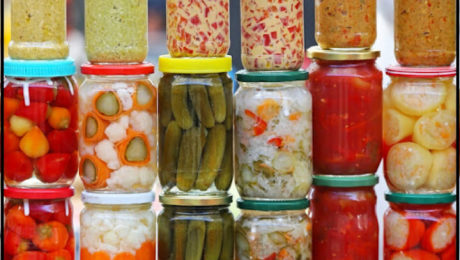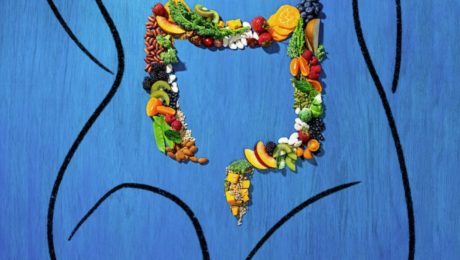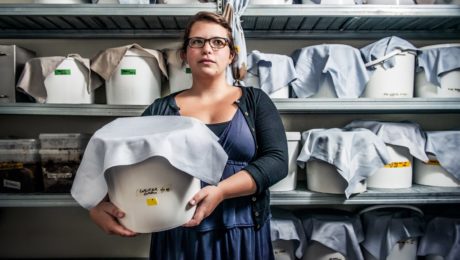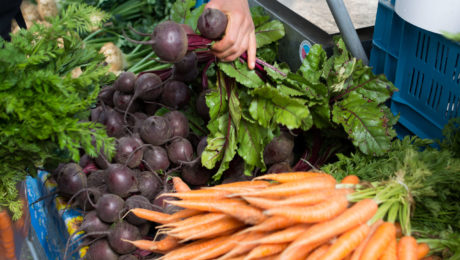Fermented Foods Reduce Stress
Researchers have made a breakthrough discovery in stress management: fermented food can change one’s mood.
Scientists from the University College Cork (UCC) APC Microbiome research center found consuming 2-3 servings of fermented foods a day – like sauerkraut, kefir, kimchi, kombucha, yogurt, etc. – improves mental health. Stress and depressive symptoms are reduced when regularly consuming fermented foods.
Their month-long study analyzed the effects of a psychobiotic diet on adults, while the control group was given general nutrition advice in line with the food pyramid. The psychobiotic diet is designed to target the gut microbiome. It includes fermented foods, fruit and vegetables high in prebiotic fibers, grains and legumes.
“Although the microbiome has been linked to stress and behavior previously, it was unclear if by feeding these microbes demonstrable effects could be seen,” said Professor John Cryan, one of the study’s lead authors, vice president for research and innovation at UCC, and a principal investigator at APC Microbiome. “Our study provides one of the first data in the interaction between diet, microbiota and feelings of stress and mood. Using microbiota targeted diets to positively modulate gut-brain communication holds possibilities for the reduction of stress and stress-associated disorders, but additional research is warranted to investigate underlying mechanisms.”
Researchers studied participants with relatively low fiber diets, measuring their perceived levels of stress before and after beginning the psychobiotic diet. Four weeks in, participants reported a strong decrease in perceived stress. Their sleep improved, too. Forty chemicals were affected by the change,
“These results highlight that dietary approaches can be used to reduce perceived stress in a human cohort. Using microbiota-targeted diets to positively modulate gut-brain communication holds possibilities for the reduction of stress and stress-associated disorders,” the study reads.
Cryan, in an article for The Telegraph, said: “The mechanisms underpinning the effect of diet on mental health are still not fully understood. But one explanation for this link could be via the relationship between our brain and our microbiome (the trillions of bacteria that live in our gut). Known as the gut-brain axis, this allows the brain and gut to be in constant communication with each other, allowing essential body functions such as digestion and appetite to happen.
“It also means that the emotional and cognitive centres in our brain are closely connected to our gut.”
He added: “The next time you’re feeling particularly stressed, perhaps you’ll want to think more carefully about what you plan on eating for lunch or dinner. Including more fibre and fermented foods for a few weeks may just help you feel a little less stressed out.”
The study was published in Molecular Psychiatrry.
Promoting Fermentation Innovation
Several obstacles prevent the innovation of fermented foods, from the lack of scientific research to a chasm between science and industry to improving the sustainability of traditional ferments.
A third of foods consumed worldwide are fermented, totalling 3,500 products. A group of European scientists is studying how those fermented foods can drive innovation in food systems.
“There’s not a clear way to improve the unique properties of traditional fermented foods using microbial organisms,” says Vittorio Capozzi, PhD, a researcher with the Institute of Sciences and Food Production (ISPA) in Italy. “We still need innovation in traditional fermented foods.”
Capozzi was one of the presenters at a side event during the October Food & Agriculture Organization of the United Nations Science and Innovation forum. PIMENTO hosted the session. PIMENTO (which stands for “Promoting Innovation of ferMENted fOods”) launched last year in Europe, a project of the European Cooperation in Science and Technology (COST). PIMENTO aims “to place Europe at the spearhead of innovation on microbial foods” by promoting fermentation’s health, diversity and production. To achieve this goal, five working groups are structured around different fermentation topics. The groups are made up of both scientist and non-scientist fermentation experts studying and eventually implementing their findings.
Traditional ferments have “an important part of biodiversity that we cannot neglect,” Capozzi says. Fermentation provides new microbial-based solutions for a variety of foods, from plant-based ferments to alternative proteins. Innovations can improve nutrition and sensory qualities.
“In this way we are preserving biodiversity that has huge potential in biotechnology, science and innovation,” he says.
Ferments, he notes, can be protected. For example, a ferment produced in a specific geographical region (tequila in Mexico), a protected diversity, vegetable type, animal product or the human behavior used in production (Salers cheese in France).
“Fermented foods have been shaped through the centuries,” says Effie Tsakalidou, professor at the Agricultural University of Athens in Greece. “We have a lot of diversity.”
One of PIMENTO’s tasks is to create a database on European fermented foods. This list would include food types, production, consumption volume, technological parameters and legal status (like certifications).
Speaking on the health benefits and risks of fermented foods, Smilja Todorović, PhD, a professor at the Institute for Biological Research in Serbia, notes there’s a dearth of reputable, peer-reviewed studies on fermented foods.
“One of the very important things is to identify gaps in scientific evidence regarding benefits and risks,” she says.
The current studies on fermented foods are few and limited. Research does prove consuming fermented foods is correlated with overall mortality, decreased risk of diabetes, certain cancer types, high blood pressure and cardiovascular diseases. Todorović says that’s not enough.
“Unfortunately, when we look at scientific evidence to claim health properties, we can see that there are insufficient evidence. So all we have is a growing scientific interest in fermented foods and their impact on human health. However, we need to move from promising results to scientific evidence,” he says.
PIMENTO’s working groups are cataloging fermented foods’ impact on the gastrointestinal symptom, allergies, immunity, bone health and neurological projects. They also plan for projects studying fermented foods bioactive compounds, vitamin production and functionality; and fermented foods use in personalized diets.
The lack of studies prevents innovations in the field. Antonio del Casale, co-founder and CEO of Microbion, an agro-industrial microbiology company, says there is a disconnect between the scientists studying fermented foods and fermented food producers. He calls it “a valley of death.” The research on fermented foods is low, but the development of commercial resources are increasing.
“The problem is how to avoid the limitations of developing the food in this sector,” he says.
Using Genomics to Improve Beer
A group of Belgian scientists have not only identified the gene responsible for much of the flavor of beer and other alcoholic beverages, they’ve also engineered it for brewers.
By screening large numbers of yeast strains, researchers were able to identify the genes responsible for beer’s flavor.
“To our surprise, we identified a single mutation in the MDS3 gene, which codes for a regulator apparently involved in production of isoamyl acetate, the source of the banana-like flavor that was responsible for most of the pressure tolerance in this specific yeast strain,” said Johan Thevelein, Ph.D., an emeritus professor of Molecular Cell Biology at Katholieke Universiteit, and one of the researchers. His team pioneered the technology that identifies the genes responsible for commercially important traits in yeast.
Important to the study was finding the gene successful at creating flavor on a commercial scale. Modern, large-scale beer brewers use tall, cylindrical fermentation tanks compared to the traditional shorter vats. While the taller tanks are easier for brewing, it negatively impacts the beer’s taste. That’s because, when beer ferments, the yeast coverts 50% of the sugar in the mash to ethanol and the other 50% to carbon dioxide. But carbon dioxide pressurizes in the modern closed vessels, dampening flavor.
Using the gene editing technology CRISPR/Cas9, Thevelein and his team were able to engineer the MDS3 gene for other brewing strains, improving their tolerance of carbon dioxide pressure and improving the flavor.
“That demonstrated the scientific relevance of our findings, and their commercial potential,” Thevelein added in a statement.
“The mutation is the first insight into understanding the mechanism by which high carbon dioxide pressure may compromise beer flavor production,” said Thevelein, who noted that the MDS3 protein is likely a component of an important regulatory pathway that may play a role in carbon dioxide inhibition of banana flavor production, adding, “how it does that is not clear.”
The technology has also been successful in identifying genetic elements important for rose flavor production by yeast in alcoholic drinks, as well as other commercially important traits, such as glycerol production and thermotolerance.
The results of their study were published in Applied and Environmental Biology, the journal for the American Society for Microbiology.
- Published in Science
Upcycling & Zero Waste
Fermentation is a powerful culinary tool for upcycling.
During the Upcycling and Zero Waste session at FERMENTATION 2022, six fermentationists with diverse backgrounds in the industry shared how they’re using fermentation to reduce food waste.
“As a chef, we are constantly chasing these depths of flavors and things that you can’t get in regular cooking applications or techniques. Fermentation opened up a whole new world of flavor,” says Jessica Alonzo, a fermentation specialist and owner of small batch ferments company Native Ferments in Texas. “We were looking to enhance diner’s experience and fermentation did that.”
The panelists from all over the world included: Alonzo, Jeremy Kean (chef/owner of Brassica Kitchen), Mac Krol (CEO/founder of Mac Ferments), Richard Preiss (cofounder and brewing scientist at Escarpment Labs), Michelle Ruiz (CEO/co-founder of Hyfé Foods) and Ismail Samad (founder of Loiter and Wake Robin Foods).
Aiding farmers
Alonzo consults with area restaurants to build unique larders. She helped create the fermentation and whole food utilization program at Petra and the Beast as the former sous chef. Fermenting the restaurant byproducts helped the restaurant eliminate food scraps, cut down on food cost and partner with farmers.
Up to 40% of food grown in America is thrown away, according to the U.S. Department of Agriculture.
“I got into zero waste and upcycling through relationships with farmers, seeing how much was wasted at the farm level,” says Samad, who also co-founded and was executive chef at The Gleanery in Vermont. “The Gleanery existed for the last 12 years to provide a very clear safety net for farmers not selling their stuff at the farmers market.
Samad admits he didn’t know much about fermentation when he first started, “We just knew we didn’t want to keep wasting food.” By fermenting the kitchen scraps, “we’re making sacrifices that big food won’t do.”
Exploring Science
At a scientific level, Preiss at Escarpment is looking at upcycling “through a microbiologist lens.” Preiss said he began upcycling when he realized the current food system is unsustainable in a linear economy.
“There’s a lot of opportunity for creating circular food economies to not only reduce waste but help every single stakeholder involved in this process make more money, pay people more, create jobs, be more profitable and ultimately stay open as part of the sustainability discussion,” he says.
Restaurants are often leading upcycling and fermentation conversations – “many people know about fermentation because of restaurants.” But Preiss says the craft beer industry is becoming a leader in the upcycling movement because, today, they’re in many neighborhoods. “They have a really cool platform to communicate new ideas around food innovation.”
Escarpment is exploring interesting ways to use spent grains from beer. Currently, they’ve created a way to make seasonings. Brewers use those seasonings in their menu dishes, a novelty that gets customers excited about pairing a beer with a dish seasoned with that craft brew’s spent grain.
“There’s a lot of opportunity in that grain, there’s still a lot of nutritional quality,” Preiss says. “Through fermentation, we unlock new possibilities.”
Hyfé Foods is also utilizing waste. They’re taking the discarded sugar water (typically used in beverage production) and, through fermentation, repurposing it in mycelium flour. Mycelium is a type of mushroom. Hyfé’s proprietary biotechnology makes a protein-rich, low carb mycelium flour in a carbon-neutral, affordable process.
“Often when a manufacturer makes a product, the lifecycle being considered ends at the door. We’re often not measuring the greenhouse gas emission impact, the wasted sugar water – that goes down the drain,” says Ruiz. Food manufacturers pay a hefty fee to get rid of waste water. “We’re really excited about the position that upcycling puts us in, not only from a cost standpoint but also we’re creating a really nutritious, low cost food.”
Upcycling Barriers
Upcycling is not without its challenges.
Kroll at Mac Ferments specializes in koji. He recently created shoyu made with used coffee grounds, koji, water and salt – an excellent choice, he says, for a restaurant that likely throws out pounds of coffee grounds at the end of the night.
“It is obviously nice to create added volume from leftovers, it tightens the whole supply chain,” Kroll says. “But also there are risks of potentially overproducing just to create extra waste. You have to be careful what you’re doing because you’re dealing with enzymes – and we don’t see microbes.”
Fermentation, he says, should be utilized for quality, not quantity.
“If every dish has something fermented, a regular customer might come home starving,” Kroll adds.
Preiss sees collaboration as a major challenge because creating a circular, upcycled system involves multiple stakeholders sharing their waste products.
“Upcycling can’t be done in a silo, you need collaboration, and getting people that have the different pieces of the puzzle together to make it happen is the biggest challenge,” he says.
Samad, meanwhile, says scaling is a hurdle. “There are opportunities for investments around upcycling, but there’s a ceiling where this culture or ethos can be sustained.”
Educating customers, too, can be tricky. The public consuming the product or dish needs to understand what is upcycled. Servers, as the mouthpiece to diners, must taste and know a dish to communicate its elements. Chefs must detail to servers where ingredients were sourced, how long the food was aged and what was cross utilized, Alonzo says.
Panelists said the public is excited about the new taste experiences with upcycled food – but they’re also more curious about the science behind it.
“Folks come into Brassica for that fermentation program and are so interested and hungry for that knowledge from the science community,” Kean says. “And then theres folks that just want to eat and say ‘What the fuck was that?’ I think it’s a mixture between the two.”
“The education around all this stuff is growing,” he adds. “I see the culinary world and science world getting closer and closer together and I think that’s the right direction.”
- Published in Food & Flavor, Science
Consumers: We’d Eat More Fermented Foods if Knew Health Benefits
The general public lacks knowledge of fermentation and does not understand the health benefits. Nearly 85% of respondents in a survey said they would consume more fermented foods if they knew more about fermentation’s health benefits.
The study illustrates much work is needed in educating consumers. Over 83% of respondents didn’t know the definition of fermentation and over 60% had limited knowledge of the microorganisms involved in fermentation. Most learned about fermented foods at school (31%), the internet (29%) or home (26%). And 72% said they felt safe consuming fermented foods.
Researchers from the University of Maribor in Slovenia studied how much people in the country know about fermentation. The results were eye-opening, especially since fermentation is more common in Europe. The study notes Slovenians commonly grow up eating local fermented foods, like sauerkraut, sour turnip and sour milk, especially in rural areas.
“Despite the fact that less than one fifth of the participants were familiar with the definition of fermentation and understood the process, almost one-third of the participants at least tried to ferment at home,” the study concludes. “Fermented foods should once again become part of the diet to improve overall health and reduce or postpone the onset of a variety of chronic diseases that plague us today.”
Read more (BMC Public Health)
Inuit Scientist on Ferments of the Arctic
When Aviaja Lyberth Hauptmann, PhD, began her research into the metagenomics of snow and ice environments, she was surprised that plant-based diets were a constant focus in the field of human gut microbiome research.
“I wondered why no one seemed to acknowledge that some peoples, and in particular Arctic Indigenous peoples, have lived healthily off animal-source foods for millennia,” she says. “It was clear to me that there is a large gap in our understanding of how healthy animal-source foods affect the microbiome. And not just animal-source foods, but foods that are not industrially produced, foods that come straight out of our environment, including microbes from our environment.”
This has become central to Hauptmann’s research. She’s published two papers on Inuit foods. Her latest, on Inuit ferments, was published with Maria Marco, PhD, food science professor at University of California, Davis (TFA Advisory Board member). That study, published in the journal Microbiome Research Reports, concluded the way to “understand the value of these traditional animal-sourced foods” is to combine new microbiological techniques with projects led by the Inuit “who make and consume fermented foods.”
In an interview with Microbiome Research Reports, Hauptmann notes that most people consider the Arctic a harsh, barren and cold place. “But Inuit describe the vast sea ice as some might describe a garden. It is full of life and food. The Arctic is a source of diverse and abundant diets if one knows how to tap into the abundance and diversity, and an important aspect of that is food preservation and of course fermentation.” Inuit store meat and other food when it’s been abundant, so fermentation has played a central role for the last 300 years. She hopes Inuit people will still take part in that local culture, eating and preserving the local foods.
Read more (Microbiome Research Reports)
- Published in Food & Flavor, Science
Nourishing Microbiota With Fermented Foods
The gut microbiome and how fermented foods can nourish it topped the Washington Post headlines in September. The article shared highlights from the growing number of studies that suggest “these vast communities of microbes are the gateway to your health and well-being — and that one of the simplest and most powerful ways to shape and nurture them is through your diet.” Food (and environment and lifestyle behaviors) have a much larger impact on the gut microbiome than genetics.
The article by health reporter Anahad O’Conner says science proves diverse diets make diverse gut microbiomes. Lower rates of microbiome diversity is linked to chronic diseases like obesity, diabetes and rheumatoid arthritis.
One way to increase that diversity is by eating fermented foods – the article points out yogurt, kimchi, sauerkraut, kombucha and kefir as excellent examples.
“The microbes in fermented foods, known as probiotics, produce vitamins, hormones and other nutrients. When you consume them, they can increase your gut microbiome diversity and boost your immune health, said Maria Marco, a professor of food science and technology who studies microbes and gut health at the University of California, Davis.”
A study by researchers at Stanford – and published last year in the journal Cell – found people who eat fermented food regularly increase their gut microbial diversity and lower their levels of inflammation.
“While it’s clear that eating lots of fiber is good for your microbiome, research shows that eating the wrong foods can tip the balance in your gut in favor of disease-promoting microbes,” writes O’Connor. The “bad” microbes, according to research, are commonly found in highly processed foods “that are low in fiber and high in additives such as sugar, salt and artificial ingredients. This includes soft drinks, white bread and white pasta, processed meats and packaged snacks like cookies, candy bars and potato chips.
Tim Spector, professor of epidemiology at King’s College London and the founder of the British Gut Project, tells the Washington Post that eating a wide variety of plants, fiber and nutrient-dense foods is also beneficial for the gut. Spector encourages people to eat 30 different plant foods a week, which can include produce, nuts, herbs and spices.
Read more (The Washington Post)
The Flavor Whisperer on Fermentation
Flavor is much more complex than just taste. Flavor can be collected, extracted, infused, created and transformed. And, in a billion-dollar flavor industry devoted to putting flavors into processed foods, fermentation is the oldest and most natural flavor creator, developing new flavors at a molecular level.
“Fermentation as a flavor creation process in collaboration with microbes, there’s almost no limit to how you can apply it and use the ingredients around you and have a more flavorful palette to work from,” says Arielle Johnson, PhD, a flavor scientist, gastronomy and innovation researcher and co-founder of the Noma Fermentation Lab.
A food chemist dubbed the flavor whisperer, she works with restaurants on innovating dishes and cocktails. She researches how flavor is perceived and is writing a book on her studies, Flavorama. Her work comes together in “all things science and cuisine have to say to each other.”
This week Johnson shared her insights into flavor and fermentation as a guest lecturer at Harvard University’s Science & Cooking series.
Taste & Smell Receptors
Flavor can be quite complex – Johnson calls it a black box.
There are five primary tastes: sweet, sour, salty, umami and bitter. Each taste evolved to ensure humans get basic nutrition. We use sweet foods for the energy in sugar, sour ones for vitamin C from fruit and fermented foods. Salty foods provide the essential mineral sodium. We seek umami foods for the taste of glutamine, an amino acid in proteins and fermented foods.
But bitter, Johnson points out, doesn’t sense one thing. It senses multiple molecules that are potential toxins for us. This is why bitter is called an acquired taste.
Smell is Johnson’s favorite part of the flavor profile. In order to taste, we must smell, too. Molecules land in the olfactory receptors in the nasal cavity and help activate taste. This is why food is tasteless if you plug your nose while eating. But the back of the throat is also connected to the nasal cavity, so the throat becomes “the secret backdoor” for sensing flavor.
While there are five major tastes and four receptor areas on the tongue, there are 40 billion smellable molecules and 400 receptors for smell.
Supertasters vs. Nontasters
Taste and smell, she detailed, help us understand how fermentation works.
The population can be divided into supertasters or nontasters. During her presentation, Johnson had the audience put a strip of filter paper on their tongue. The paper included a harmless bitter molecule phenylthiourea (PTC), but only roughly half the class could taste it. This group are supertasters – the group who could not taste the PTC are nontasters.
She explained everyone has different density of their taste buds. Supertasters have more taste buds, so more taste receptors signals are sent to their brains. This has culinary implications. Because their sense of taste is more sensitive, flavors are intense and supertasters have a less adventurous palette. Meanwhile nontasters have dulled senses, so it takes a lot of flavor to activate taste.
“The good news for supertasters is that fermentation is usually salty and sour and often umami – all of which counteract bitterness,” Johnson says. “Fermentation is a way to create new flavors but also transform ingredients.”
Fermentation as Flavor
Though “microbes are opportunistic” and pop up in foods whether planned or not, fermentation can’t be forced, Johnson says. When making a sauerkraut, for example, microbes don’t need to be added. Fermentation works with what’s on the surface of the cabbage and on the producer’s hands.
Salt is key in fermentation as a flavor additive, a preservation element and a safety measure. Salt filters out bad molds and avoids letting a ferment spoil. Other factors “dial in the flavors in this molecular flavor creation process,” she says, like the correct ingredients, temperature control and humidity.
“We’re really excited about microbes and fermentation,” Johnson says. “In this process of this exponential growth that microbes do, they’re eating things, they’re getting energy, but they’re also running their regulator metabolism. So there’s all these waste products that are not very significant to the microbes, but that can create a lot of interesting flavor complexity.”
- Published in Food & Flavor, Science
Fermentation for Global Health
Though scientists and environmentalists have warned about the dangers of increased meat consumption, Americans’ appetite for it is not slowing down. The last three years marked the largest amount of meat produced on record.
“People know about the harms of industrial agriculture, but people eat more and more and more meat,” says Bruce Friedrich, CEO of the Good Food Institute (GFI). “It’s an inextricable rise despite more and more attention to the issues. The vast majority of people are just not going to apply ethical considerations to their food choices.”
Fermentation, Friedrich declares, can be part of the solution. “Fermentation can be so powerful for global health, climate and biodiversity,” he says.
Friedrich spoke at FERMENTATION 2022 on alternative protein innovation. GFI, a nonprofit, aims to accelerate the innovation of fermented, plant- and cell-based alternative meat. But the young, rapidly-growing alt protein industry faces major obstacles in scaling, regulation, pricing and consumer acceptance. Friedrich told a room of professional fermenters at the conference to consider shifting to a career in alternative proteins.
“Anyone involved in fermentation, you have the expertise in knowledge. It’s cross-applying the skills and interest in your professional life into this new field,” he says. “One of the significant barriers for all the companies doing this is talent, which is to say – you.”
Global Agriculture Crisis
Friedrich does not mince his words: we’re on the precipice of a major environmental and health crisis if we don’t reduce meat consumption.
Mass producing meat is “extraordinarily inefficient.” Huge amounts of crops are grown to feed livestock so humans can then eat the animals.. “We have been using an antiquated method to produce meat for 12,000 years,” Friedrich adds.
Internationally, 4 billion hectares of land are used for agriculture – 3 billion are for grazing livestock or to grow their food. It takes 9 calories of feed to produce 1 calorie of chicken; 40 calories to produce 1 calorie of beef.
“This is an incredibly inefficient way to try and feed the world,” Friedrich says.
And it’s getting worse. By 2050, global meat consumption is projected to increase – conservative estimates say 50%, while others go as high as 260%.
Animal agriculture also is thought to be a major contributor to global climate change and a major factor in deforestation. Livestock are pumped with antibiotics, creating resistance in humans that consume that meat.
Future of “Meat”
The answer isn’t necessarily a world of vegetarians – it’s to change traditional meat.
Friedrich compares the situation to renewable energy and electric vehicles. For decades, government leaders have preached reducing fossil fuel consumption. But, as populations have risen, so has energy consumption.
“You are not going to convince people to consume less energy,” he says. “What you need to do is replace fossil fuels with renewable energy.”
Similarly with meat, there cannot be a meatless world. “This is innovation focused, it is not about behavior change,” he says.
“GFI when we started, we were talking about disrupting animal agriculture. We very quickly realized our hope is to transform industrial animal agriculture,” he says. “Things will happen a lot more quickly if we have the major corporations on board.”
GFI is “enthusiastically working with the biggest companies in the world:” JBS, Tyson, Smithfield, Cargill and BRF, the five largest global meat producers.
The aim is not to regulate big agriculture or stop subsidies. GFI hopes to open access into the science behind alternative proteins, incentivize the private sector to continue R&D and encourage government funding.
“The same sort of cash breaks that allowed Tesla to be successful should apply to Nature’s Fynd and Impossible Foods and others if they want that money,” Friedrich says, listing two major companies in the alternative protein industry. “Our global battle cry is that governments should be funding alternative proteins.”
Food Trifecta
By not gatekeeping alt protein technology, Friedrich says GFI is helping perfect the process of giving consumers the exact same meat experience, but using plant- or cell-based meats. People want the food trifecta, Friedrich says: Is it delicious? Does it fill me up? Is it reasonably priced?
Fermentation is a booming sector in the alternative protein industry. It is split into three categories: traditional fermentation using lactic acid bacteria, yeasts or fungi; biomass fermentation which involves naturally occurring, protein-dense, fast-growing microorganisms; and precision fermentation, which uses microbial hosts as “cell factories” to produce specific ingredients.
Data from GFI found, of the alt protein startups utilizing fermentation, 45% use precision fermentation, 41% use biomass fermentation and the remaining 14% use traditional fermentation.
GFI recently hired two fermentation scientists, and their studies are already suggesting biomass and traditional fermentation will have better environmental numbers than plant-based meats. Fermentation is also a more powerful process than plant-based meat applications because fermentation can replicate precise fermentation proteins. And although traditional fermentation is the smallest part of the fermented alternative protein category, GFI sees it growing because of its ability to produce appealing flavors..
“Traditional fermentation can be an absolutely essential element to get meat to taste the same or better or cost the same or less,” he says.
“The plant based and fermentation products, they’re just getting started. The idea of competing with industrial animal meat has been around for (snaps his fingers) that long. The products are just going to improve and improve and improve.”
Does Organic vs. Conventional Matter for Fermented Foods?
Organic food is considered by some to be healthier and more nutritious than its conventional counterpart. But what about when that food is fermented? Does organic vs. conventional matter?
A new study reveals some surprising results: when it comes to fermented foods, “the quality of organic food is not always better than conventional food.”
Organic vs. conventional agricultural production is a hotly debated topic – some reports indicate organic food is more nutritious, but other research suggests the nutritional differences are not significant. Meanwhile, fermented foods are scientifically-proven to include higher nutritional value. “During fermentation, the concentration of many bioactive compounds increases, and the bioavailability of iron, vitamin C, beta carotene, or betaine is also improved,” the study notes. Fermented products also “inhibit the development of pathogens in the digestive tract.”
Researchers at the Bydgoszcz University of Science and Technology in Poland questioned whether fermenting organic food would change its nutritional output versus using conventional food. Their results were published in the journal Molecules.
Analyzing fermented plants (pickles, sauerkraut, beet and carrot juices) and dairy (yogurt, kefir and buttermilk), researchers measured the vitamins, minerals and lactic acid bacteria in the items. They compared using organic ingredients in one group to products made from conventional ingredients.
“Research results do not clearly indicate which production system–conventional or organic–provides higher levels of bioactive substances in fermented food,” the study reads.
Results were mixed. Lactic acid bacteria – the good, healthy kind – were higher in organic sauerkraut, carrot juice, yogurt and kefir. Organic kraut and pickles produced more vitamin C than conventional versions. And calcium levels were higher in yogurt made with organic milk.
But, interestingly, lactic acid bacteria levels were higher in conventional pickles and beet juice. Conventional beet juice also had five times more beta-carotene (vitamin A).
Read more (Molecules)










